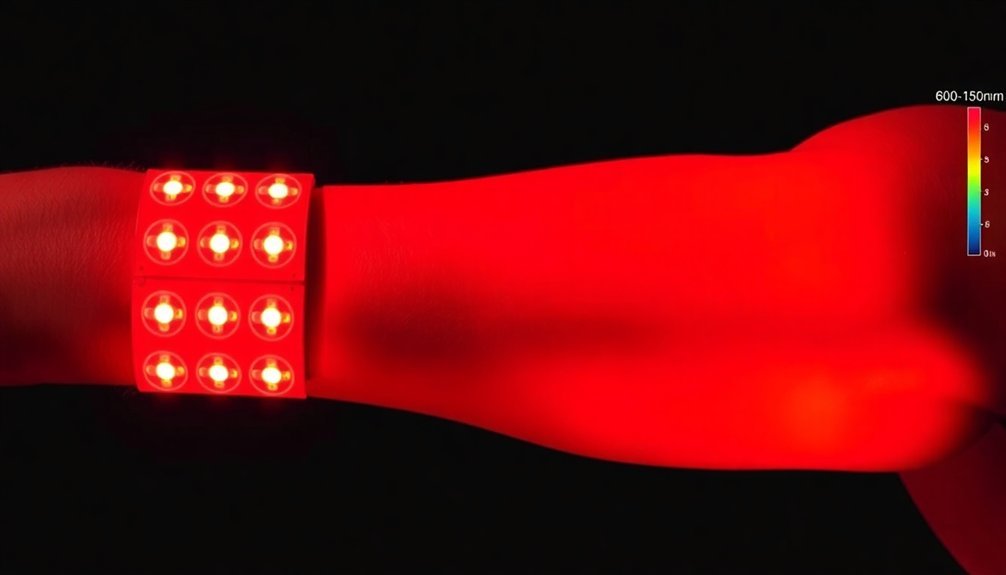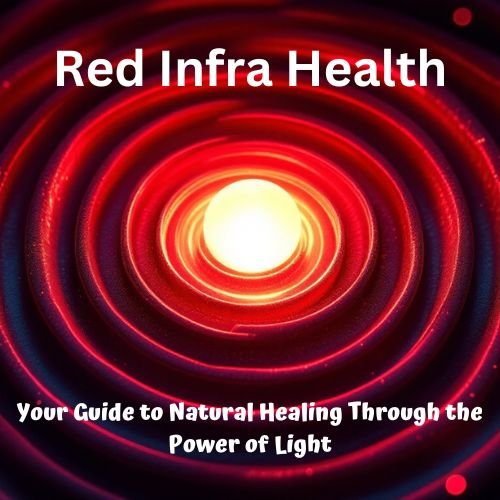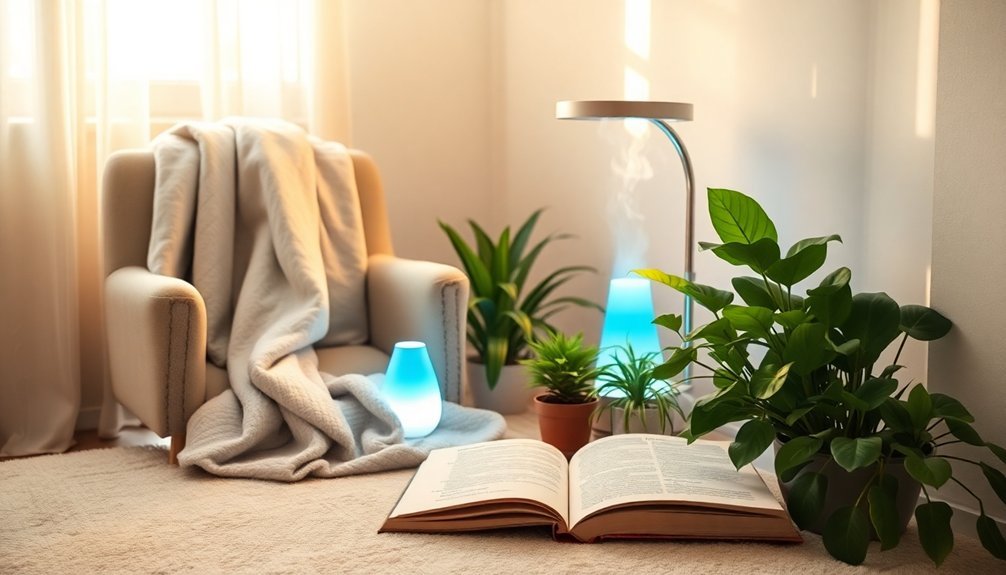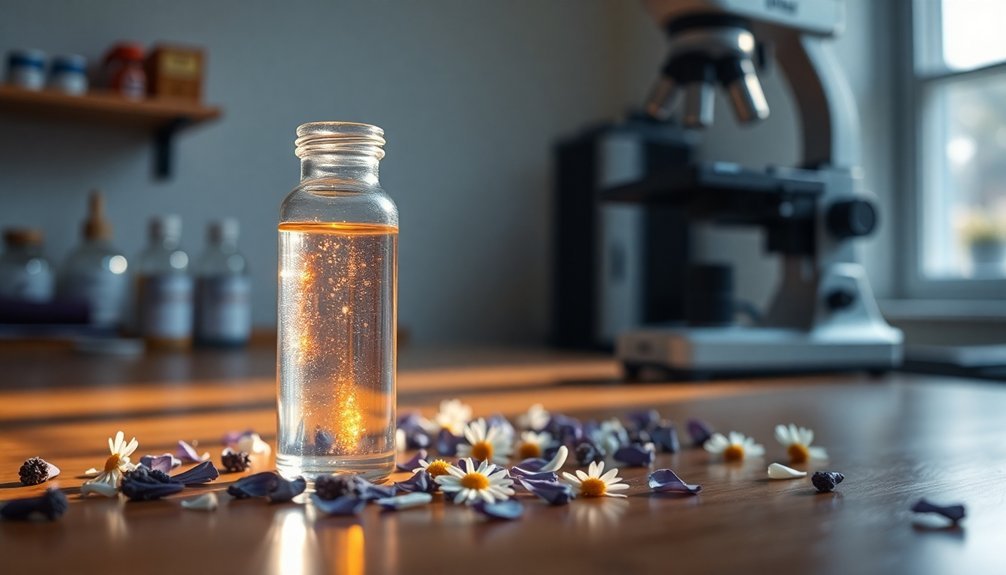The most effective LED frequencies for deep tissue recovery combine specific wavelengths that target different depths. You'll get the best results using 630nm for surface healing, 660nm for mid-level tissue repair, and 850nm for deep penetration into muscles and joints. For enhanced recovery, include 810nm and 830nm wavelengths, which boost cellular regeneration and reduce inflammation. Position your LED device 10-15cm from the skin and use it for 10-20 minutes, 3-5 times weekly. Your treatment's power density should range from 10-200 mW/cm² depending on the target area. Discover how combining these frequencies with proper technique can maximize your recovery potential.
Understanding LED Light Therapy Basics

The science behind LED light therapy reveals a groundbreaking approach to skin and tissue treatment. You'll find this non-invasive, painless method works effectively on all skin types, addressing various conditions from acne to aging without any downtime needed. Originally developed by NASA scientists, LED therapy was first used to stimulate plant growth in space before being adapted for medical use.
LED therapy works by using specific wavelengths of light that penetrate your skin at different depths. Each color serves a unique purpose – red light stimulates collagen production deep within your tissue, while blue light targets acne-causing bacteria on the surface.
These varying wavelengths trigger distinct biological responses, promoting healing and reducing inflammation throughout your skin's layers.
When comparing LED therapy to laser treatments, you'll notice some key differences. While LEDs operate at lower power outputs than lasers, they're still remarkably effective for their intended purposes.
Though lasers penetrate deeper due to their concentrated beams, LED treatments offer gentler, cumulative benefits through regular sessions. You can even find at-home LED devices in various forms, including masks and wands, though they're typically less powerful than professional equipment.
Understanding these basics helps you make informed decisions about which treatment might work best for your specific recovery needs.
Near-Infrared Wavelengths for Muscle Recovery
Building on the foundational principles of LED therapy, near-infrared wavelengths offer remarkable benefits for muscle recovery. These wavelengths, ranging from 700-1200 nm, work alongside red light (630-700 nm) to penetrate deep into muscle tissue and trigger cellular healing through photobiomodulation. The noninvasive nature of LED therapy ensures minimal heat generation during treatment.
You'll experience enhanced muscle recovery through several key mechanisms. The light stimulates your mitochondria to produce more ATP, boosting cellular energy and function. It also increases blood flow to your muscles, which helps remove metabolic waste and deliver essential nutrients. This process substantially reduces inflammation and accelerates healing time.
To maximize these benefits, you'll want to follow specific usage guidelines. Apply the light therapy for 5-10 minutes before workouts and 10-20 minutes after exercise, keeping the device 6-12 inches from your skin.
For injury rehabilitation, extend sessions to 15-30 minutes.
However, you shouldn't overdo it. The effectiveness follows the Arndt-Schulz curve, meaning more isn't always better. Your cells have an ideal dose threshold, and exceeding it can diminish the benefits or potentially activate harmful pathways.
Stick to 3-4 sessions weekly for general recovery, adjusting based on your body's response.
Optimal Frequencies for Joint Healing

Powerful LED wavelengths between 620-690 nanometers offer targeted healing for damaged joints and connective tissue. The most effective frequencies fall within two specific ranges: 610-630nm and 660-690nm, with 660nm being particularly potent for deep tissue penetration and repair. This wavelength effectively stimulates collagen synthesis in damaged cartilage tissue.
You'll find compelling evidence supporting LED therapy's effectiveness for joint healing. Studies show it can reduce arthritis pain by over 50% in knee osteoarthritis patients and substantially decrease back pain scores from 6.9 to 3.0. For sprained ankles, just six days of treatment results in measurable reductions in pain and swelling.
To achieve the best results, you'll want to follow a specific treatment protocol. Apply the light therapy for 5-15 minutes, 3-4 times weekly, for 4-6 weeks.
After this initial period, switch to maintenance sessions once or twice per week. When selecting a device, make certain it delivers sufficient power density and uses FDA-cleared technology. Look for devices featuring both 660nm and 850nm wavelengths, as this combination proves most effective for joint healing and tissue repair.
Remember to maintain proper distance between the device and your skin to maximize the therapy's benefits.
Red Light Benefits for Tendons
Red light therapy offers remarkable benefits for tendon healing through multiple biological mechanisms. When you use red light therapy on injured tendons, it stimulates collagen production from tenocytes while managing excessive inflammation – two essential factors in the healing process.
You'll experience enhanced blood circulation, which delivers essential nutrients and oxygen to the damaged area, accelerating recovery. The therapy helps decrease lactic acid buildup to minimize discomfort during the healing process.
This non-invasive treatment proves particularly effective for conditions like Achilles tendonitis, where it reduces pain and improves mobility. Your tendons receive targeted support through cellular stimulation, promoting faster tissue repair and reducing recovery time.
- Picture your injured tendon receiving waves of healing red light, penetrating deep into the tissue where it activates cellular repair mechanisms.
- Visualize increased blood flow bringing essential nutrients to your damaged tendon, like a healing river flowing through the affected area.
- Imagine your tendon cells awakening and producing fresh collagen, rebuilding the injured tissue fiber by fiber.
- See the inflammation subsiding as the red light works its therapeutic effects, restoring your tendon's natural function.
For athletes and active individuals, this therapy can substantially speed up recovery and help you return to your activities sooner.
LED Power Output Requirements

To achieve meaningful deep tissue recovery with LED therapy, you'll need devices that output at least 150 watts for ideal penetration and therapeutic effect.
Your LED device should deliver an intensity between 5mW/cm^2 to 50mW/cm^2 to meet clinical standards for effective treatment.
While lower-powered devices around 50-100 watts can work for surface-level treatments, you'll get faster and more substantial results for muscle and joint recovery with higher-powered systems that can effectively reach deeper tissues.
Optimal Wattage For Results
Light therapy effectiveness hinges more on ideal power delivery than raw wattage numbers. While you'll find devices ranging from 50W to over 150W, matching the power output to your specific recovery needs is crucial.
For deep tissue treatment, you'll want devices delivering at least 100 mW/cm² of irradiance, though surface-level therapy can be effective with lower intensities.
- Imagine a focused laser beam penetrating deep into muscle tissue, requiring 150+ watts for maximum effectiveness.
- Picture a broader LED panel covering your entire back, efficiently distributing 100-150 watts across a larger surface.
- Visualize treating a smaller area like your knee, where a 50-100 watt device provides ample power.
- Consider the difference between a concentrated beam of light versus a dispersed glow, affecting how deeply the energy reaches.
You'll get the best results by considering your treatment distance, area size, and personal sensitivity when selecting wattage.
Remember that high-quality LEDs can deliver effective treatment even at lower wattages if they're designed for efficient energy use.
The key isn't always choosing the highest wattage – it's finding the right balance for your specific recovery needs.
LED Power Density Standards
While wattage provides a starting point for LED therapy, understanding power density standards gives you a more precise measure of treatment effectiveness.
For deep tissue recovery, you'll need power densities between 500-1000+ mW/cm², markedly higher than the 5-50 mW/cm² used in standard therapeutic applications.
When targeting deeper tissues, don't let high power density numbers alarm you. While densities above 200 mW/cm² aren't recommended for skin treatments, they're essential for penetrating deeper layers effectively. The key is understanding that higher intensities require shorter application times to achieve the same therapeutic dose.
You'll find most clinical studies use power densities between 10-200 mW/cm², but deep tissue recovery often demands more.
When selecting a device, focus on the actual power density output rather than marketed wattage claims. Remember that light intensity decreases with distance from the source, so a device's beam angle considerably impacts its effectiveness.
Look for LED devices that deliver consistent, powerful doses while maintaining energy efficiency. The best units will provide the necessary irradiance without excessive power consumption, often featuring automatic shut-off timers to guarantee ideal treatment duration.
Combining Multiple Wavelength Treatments
When you're planning multiple wavelength LED treatments, combining 660nm red light with 850nm near-infrared light creates powerful synergistic effects for both surface and deep tissue recovery.
You'll want to start with shorter 5-10 minute sessions using both wavelengths simultaneously, rather than separating them into different treatments, to activate multiple biological pathways at once.
For best results, you can gradually increase your session duration while maintaining high power output, as both wavelengths work together to enhance healing responses throughout different tissue depths.
Optimal Wavelength Pairing Strategies
In accordance with recent research, combining multiple LED wavelengths creates powerful synergistic effects that enhance deep tissue recovery. When you're using multi-wavelength therapy, you'll benefit from deeper tissue penetration and activation of various biological pathways that can't be achieved with single wavelengths alone.
The most effective combinations typically include both 660nm and 850nm wavelengths, supported by complementary frequencies like 630nm, 810nm, and 830nm.
To visualize the depth and impact of multi-wavelength therapy, consider these key penetration points:
- Surface level (630nm) – Enhances cellular membrane function and improves absorption
- Mid-level tissue (660nm) – Targets inflammation and accelerates wound healing
- Deep tissue (850nm) – Reaches muscle and bone for thorough recovery
- Systemic level (combined wavelengths) – Activates multiple photoreceptors throughout the body
You'll achieve superior results by using devices that incorporate multiple wavelengths rather than limiting yourself to dual-wavelength systems.
This approach guarantees uniform cell activation across various tissue depths while targeting multiple conditions simultaneously.
For whole-body applications, multi-wavelength configurations provide the most extensive therapeutic benefits and best tissue recovery outcomes.
Timing Multiple Light Sessions
Timing your LED light therapy sessions correctly can maximize their therapeutic benefits and prevent overexposure. You'll want to schedule 3-5 sessions per week, with each session lasting 10-20 minutes.
Don't attempt multiple sessions in a single day, as this can lead to skin irritation and diminished results.
When you're combining different wavelengths, you can use them simultaneously to achieve enhanced therapeutic effects. Multiple wavelengths, such as 660nm and 850nm paired with 610nm, 630nm, 810nm, or 830nm, work together to target various tissue depths and activate different biological pathways.
You'll get better results using these combinations in short, consistent sessions rather than lengthy, sporadic treatments.
Position yourself 10-15 cm from the light source for ideal absorption. You can schedule your sessions at any time, but morning treatments tend to be energizing while evening sessions promote relaxation.
If you're treating specific conditions like pain, you might start with daily sessions before reducing to 3-5 times weekly. For skin rejuvenation, stick to 3-5 weekly sessions, and for hair growth, every other day works best.
Treatment Duration and Frequency

Determining the right treatment schedule substantially impacts the success of LED therapy for deep tissue recovery. While sessions typically range from 15 to 30 minutes, your specific needs will dictate the ideal duration.
If you're dealing with a severe condition, you'll likely need longer sessions and more frequent treatments to achieve the best results.
Your treatment protocol should be customized based on the depth of tissue damage and the severity of your condition. For deep tissue recovery, you'll need high-power treatments that can penetrate effectively, while superficial injuries may respond well to lower-power options.
- Acute injuries might require daily 15-minute sessions for the first week
- Chronic conditions often need 30-minute sessions scheduled 2-3 times per week
- Maintenance treatments can be spaced out to once every 2-4 weeks
- Post-recovery sessions should last 20 minutes monthly to prevent relapse
The effects of LED therapy can last from several days to months, depending on your condition and overall health. You'll typically notice better results with consistent treatment adherence, and combining LED therapy with other recovery methods can enhance your outcomes.
Proper LED Placement Techniques
When treating joints with LED therapy, you'll want to position the device directly on the skin above the affected area, ensuring maximum light penetration to the target tissues.
For effective results, keep the LED panel within 6-12 inches of the treatment area while adjusting the distance based on the device's power and the depth of tissue you're targeting.
If you're working with multiple devices, arrange them strategically to provide thorough coverage of larger treatment zones, especially when addressing complex joints like knees or shoulders.
Position For Joint Treatment
Proper positioning of your LED device plays a crucial role in achieving ideal therapeutic results for joint treatment. You'll need to secure the device snugly against your skin, ensuring direct contact between the light source and the affected area.
For maximum effectiveness, position the nodules precisely over the painful spots, adjusting the spacing and angles to target the specific joint you're treating.
When treating individual joints, follow these specific placement guidelines:
- For knee treatment, wrap the device around your knee joint, securing straps evenly to maintain consistent contact while allowing comfortable movement.
- For shoulder therapy, position the device directly over your shoulder joint, using straps to hold it firmly in place while targeting both front and back areas.
- For ankle care, wrap the device around your ankle bone, ensuring the nodules contact both sides of the joint.
- For neck treatment, position the device around your neck without over-tightening, allowing the light to penetrate the affected vertebrae.
Remember to follow manufacturer's guidelines for treatment duration and combine your LED therapy with other recovery methods like gentle stretching for effective results. Maintain daily sessions and consistent positioning to maximize therapeutic benefits.
Distance From Target Area
Maintaining the ideal distance between your LED device and the treatment area substantially impacts therapeutic effectiveness. You'll want to position your LED strips at a distance that maximizes light penetration while avoiding harsh concentrations or scattered dispersion. Consider using deep surface extrusions to help diffuse the light evenly across the target tissue.
When placing your LED device, angle it directly toward the treatment area to achieve optimal light delivery. You'll need to adjust the positioning to minimize shadows and achieve consistent coverage across the entire target zone.
If you're working with joints or curved surfaces, you might need to experiment with different angles to maintain uniform light distribution.
For deeper tissue penetration, you'll want to position the LEDs closer to the skin while still maintaining enough distance to prevent heat buildup. Consider using mounting solutions that provide stable, adjustable positioning.
Remember to keep the surface clean and dry before securing your LED device, as proper adhesion is vital for maintaining consistent treatment distance.
If you're using multiple LED strips, make sure they're positioned to provide overlapping coverage without creating hot spots or gaps in the treatment area.
Multiple Device Coverage Tips
Strategic placement of multiple LED devices creates a synergistic effect for thorough tissue recovery. When you're using multiple panels, you'll want to position them adjacent to or stacked upon each other to maximize coverage area and treatment intensity.
This multi-unit approach allows you to target larger muscle groups or treatment areas while maintaining consistent power density across the target zone.
- Place panels side by side to treat broad areas like your back, creating an overlapping pattern that guarantees complete coverage.
- Stack compatible devices vertically when you need concentrated therapy for deep tissue concerns.
- Adjust panel heights using mobile stands to maintain the ideal distance from different body parts during treatment.
- Configure panels in an array formation for whole-body treatment sessions.
For maximum efficiency, combine different wavelengths to penetrate various tissue depths simultaneously. You'll achieve better results by customizing your setup based on the specific condition you're treating.
Remember to maintain consistent 20-minute treatment sessions unless otherwise specified for your condition. If you're using multiple devices, guarantee they're compatible and can be controlled individually for precise treatment customization.
Measuring Treatment Effectiveness

Accurately measuring LED therapy's effectiveness presents unique challenges due to widespread inconsistencies in research methodologies and dose reporting. Studies reveal fluence variations of over three orders of magnitude for identical conditions, highlighting the need for standardized measurement approaches.
To properly measure your LED therapy's effectiveness, you'll need calibrated optical power sensors that can read power density in mW/cm² or W/m². While solar power meters can provide rough estimates, specialized LED light meters offer superior accuracy for specific wavelengths.
You should guarantee your measuring device is calibrated to match your LED's wavelength for precise readings.
When evaluating treatment effectiveness, consider the therapeutic depth requirements of your target tissue. LED therapy works best for superficial treatments, as it can't penetrate as deeply as high-power lasers or radiofrequency devices.
If you're targeting deeper tissues, you might need to combine LED therapy with other modalities. For instance, high-power RF delivers focused energy to deeper layers, while LED therapy can optimize mitochondrial function and enhance overall treatment outcomes.
Using equivalent solar exposure time as a metric can help you compare your LED treatment doses to natural sunlight exposure.
LED Safety Protocols
When implementing LED therapy, following proper safety protocols is critical to prevent adverse effects and maximize treatment benefits. Before starting treatment, you'll need to consult with a certified skincare professional who can assess your skin condition and create a personalized treatment plan.
If you're taking anti-inflammatory medications or experiencing light sensitivity, it's crucial to discuss these factors with your healthcare provider.
During treatment, you must protect your eyes with specialized goggles and verify that your skin is clean and product-free. Always perform a patch test before full facial treatment and strictly follow the manufacturer's instructions regarding treatment duration and frequency.
Here are four key visual indicators that you're following proper safety protocols:
- Your protective eyewear fits snugly with no light leakage around the edges
- The LED device is positioned at the recommended distance from your skin
- Your treatment timer is set and visible
- Your skin is completely clean and dry before device contact
Post-treatment, monitor your skin for any unusual reactions and maintain proper device cleaning protocols. If you're using a home LED device, verify that it's FDA-cleared and follow the recommended treatment schedule to prevent overuse.
Frequently Asked Questions
Can LED Therapy Help With Nerve Regeneration After Surgery?
Yes, LED therapy can help your nerve regeneration after surgery. It'll boost mitochondrial function, enhance axonal growth, and promote healing. Studies show significant improvement in recovery when using wavelengths of 660-780nm during treatment.
Does Skin Color Affect the Effectiveness of LED Treatment?
Yes, your skin color can affect LED treatment results. While red light therapy works well for all skin types, you'll need to be cautious with blue light if you have darker skin or freckles (Fitzpatrick III-IV).
Should I Continue LED Therapy During Acute Muscle Inflammation?
Yes, you should continue LED therapy during acute muscle inflammation. It'll help reduce swelling, enhance blood flow, and speed up healing. Just make certain you're using appropriate wavelengths and following recommended treatment protocols.
Can Medications Interfere With LED Light Therapy Effectiveness?
Yes, your medications can interfere with LED therapy. If you're taking immunosuppressants or photosensitizing drugs, they'll reduce effectiveness and may cause reactions. Always check with your doctor before starting LED treatment.
Are At-Home LED Devices as Effective as Professional Clinical Treatments?
While you can achieve results with at-home LED devices, they're not as powerful as professional treatments. You'll need longer or more frequent sessions to match clinical results due to lower energy output.
In Summary
LED light therapy can transform your recovery routine when you're using the right frequencies and protocols. You'll get the best results by combining near-infrared (850nm) and red light (660nm) wavelengths, maintaining consistent treatment times, and following proper safety guidelines. Remember to track your progress and adjust settings as needed. For deep tissue healing, you're now equipped to make informed decisions about LED therapy for ideal recovery outcomes.





Leave a Reply